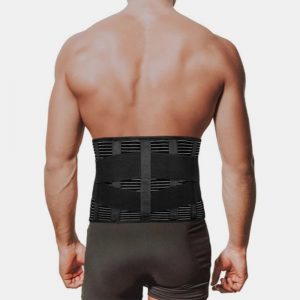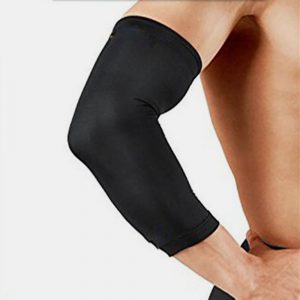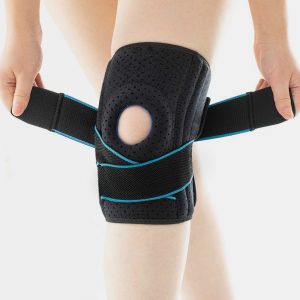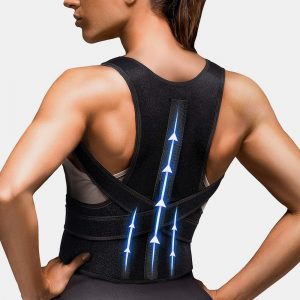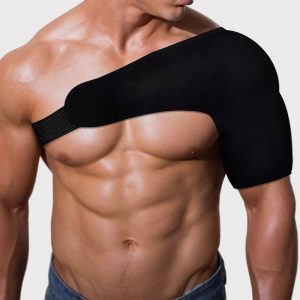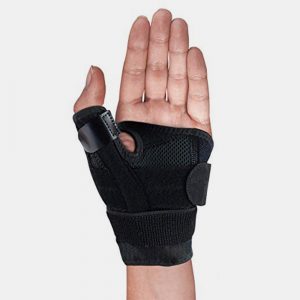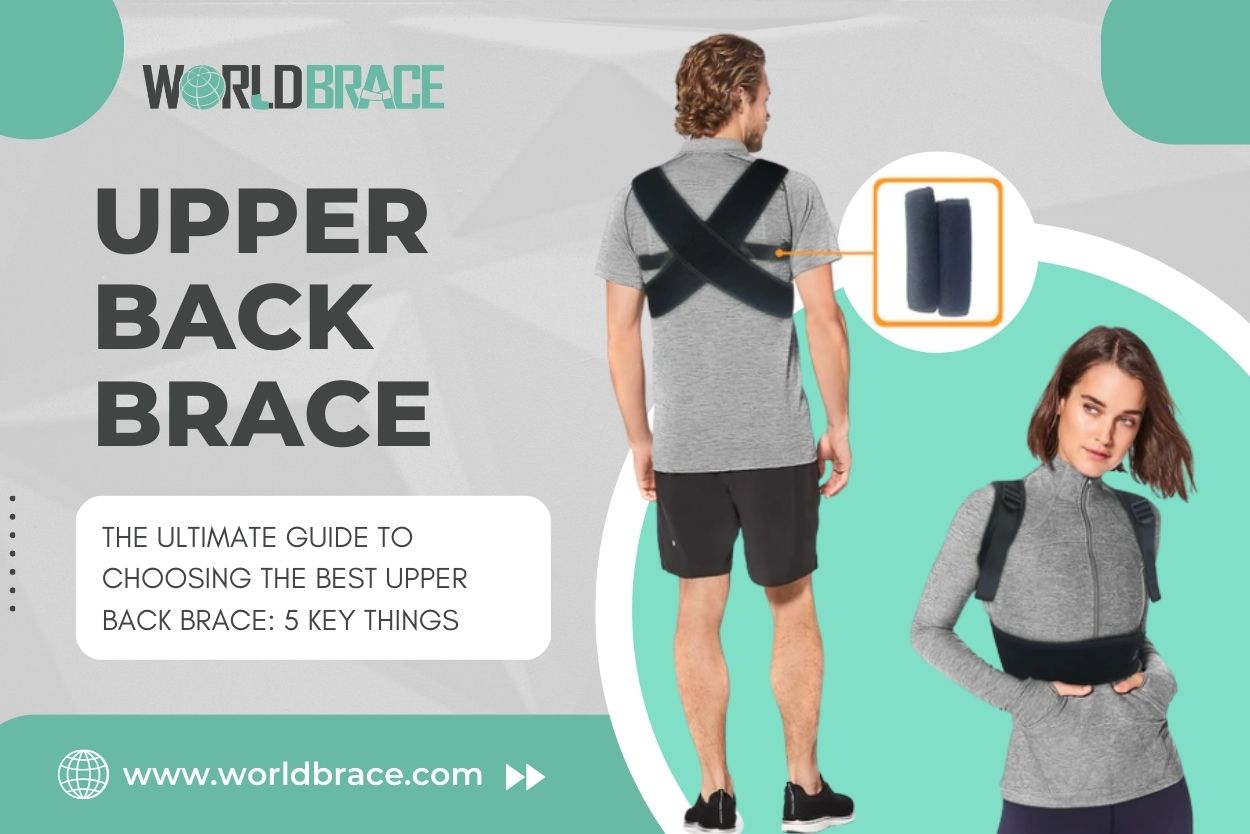
فهم آلام أعلى الظهر
يمكن أن تتسبب عوامل مختلفة، بما في ذلك الوضعية السيئة وإجهاد العضلات أو الإصابة وتشوهات العمود الفقري، في حدوث آلام أعلى الظهر. يمكن أن تتراوح الأعراض من الانزعاج الخفيف إلى الألم الحاد المنهك. يمكن أن يؤدي الألم في أعلى الظهر أيضاً إلى الصداع وآلام الكتف وصعوبة الحركة. يمكن أن يؤدي ألم الجزء العلوي من دعامة الظهر في تخفيف الألم من خلال توفير الدعم والاستقرار للمنطقة المصابة. يمكن لدعامة الجزء العلوي من الظهر أن تقلل من إجهاد العضلات وتساعد على منع المزيد من الإصابات من خلال تقييد الحركة وتعزيز الوضعية السليمة.
أنواع دعامات أعلى الظهر
عندما يتعلق الأمر بأقواس الظهر العلوية، هناك عدة أنواع مختلفة متوفرة في السوق. تتضمن بعض الأنواع الأكثر شيوعاً ما يلي:
- مصححات الوضعية: تساعد على تحسين وضعية الجسم عن طريق سحب الكتفين إلى الخلف ومحاذاة العمود الفقري. وغالباً ما تكون خفيفة الوزن ويمكن ارتداؤها بشكل خفي تحت الملابس.
- دعامات الدعم: صُممت هذه الدعامات لتوفير دعم إضافي لمنطقة أعلى الظهر والكتفين، خاصةً لأولئك الذين عانوا من إصابة أو ألم مزمن. وغالباً ما تكون مصنوعة من مواد أكثر تحملاً وقد تكون أكبر حجماً من مصححات الوضعية.
- الدعامة الضاغطة: توفر الدعامات الضاغطة الضغط والدعم لعضلات أعلى الظهر، مما يقلل من الألم والالتهاب.
- دعامة دعم الصدر: يدعم هذا النوع من الدعامات العمود الفقري الصدري، وهو الجزء العلوي من العمود الفقري الذي يتصل بالقفص الصدري. وهي تساعد على تصحيح الاختلالات الوضعية وتحسين محاذاة العمود الفقري.
- دعامة الكتف: تعمل دعامة الكتف على دعم مفصل الكتف والعضلات المحيطة به، مما يساعد على تخفيف آلام أعلى الظهر الناتجة عن إصابات الكتف.
من يحتاج إلى دعامات أعلى الظهر
لا تقتصر دعامات الجزء العلوي من الظهر على الأشخاص الذين يعانون من مشاكل الظهر الحالية فحسب، بل يمكن أن تكون مفيدة أيضاً للأشخاص المعرضين لخطر الإصابة بها. فيما يلي بعض الأمثلة على الأشخاص الذين قد يستفيدون من ارتداء دعامة أعلى الظهر:
- العاملون في المكاتب: إذا كنت تقضي ساعات طويلة أمام الكمبيوتر، فقد تصاب بوضعية سيئة أو انحناء الكتفين، مما يؤدي إلى آلام أعلى الظهر.
- الرياضيون: يمكن أن تؤدي الرياضات عالية التأثير مثل كرة القدم أو كرة السلة أو رفع الأثقال إلى إجهاد عضلات أعلى الظهر، مما يؤدي إلى الإصابة.
- الأشخاص المصابون بهشاشة العظام: مع تقدم الناس في العمر، تصبح عظامهم أكثر هشاشة وضعفاً، ويصبح الجزء العلوي من الظهر أكثر عرضة للكسور.
- الأفراد المصابون بالجنف: الجنف هو حالة طبية تتسبب في انحناء العمود الفقري بشكل غير طبيعي، مما يؤدي إلى آلام أعلى الظهر.
- الأفراد الذين يعانون من الانزلاق الغضروفي: يحدث الانزلاق الغضروفي عندما تندفع الأنسجة الرخوة بين الفقرات في العمود الفقري للخارج، مما يؤدي إلى انضغاط العصب وآلام أعلى الظهر.
اعتبارات عند اختيار دعامة أعلى الظهر
- نوع الدعامة: هناك دعامات مختلفة للجزء العلوي من الظهر، بما في ذلك مصححات الوضعية، والدعامات الضاغطة، والدعامات المثبتة. من المهم اختيار النوع الأنسب لاحتياجاتك.
- المقاس والملاءمة: من الضروري اختيار الدعامة التي تناسب جسمك بشكل صحيح. قم بقياس الجزء العلوي من جسمك والرجوع إلى جدول المقاسات الخاص بالشركة المصنعة للعثور على أفضل مقاس مناسب.
- المادة: يمكن أن تؤثر خامة الدعامة على متانتها وقابليتها للتهوية وراحتها. ضع في اعتبارك احتياجاتك وتفضيلاتك الفردية عند اختيار الخامة.
- مستوى الدعم: توفر بعض دعامات الجزء العلوي من الظهر دعماً أكثر من غيرها. ضع في اعتبارك مستوى الدعم الذي تحتاجه بناءً على حالتك وأنشطتك اليومية.
- الراحة: من المرجح أنك سترتدي دعامة الظهر العلوية لفترات طويلة، لذا من المهم اختيار دعامة مريحة للارتداء. ابحث عن الحشو والأشرطة القابلة للتعديل والنسيج القابل للتهوية لضمان أقصى قدر من الراحة.
كيفية استخدام دعامة أعلى الظهر والمحافظة عليها
يعد الاستخدام السليم لدعامة أعلى الظهر وصيانتها أمر ضروري لضمان توفيرها للفوائد المرجوة لوضعية الجسم وتخفيف الألم. لاستخدام دعامة أعلى الظهر بفعالية، اتبع التعليمات التي تقدمها لك الشركة المصنعة. بشكل عام، يجب عليك ضبط أحزمة الدعامة لضمان ملاءمتها بشكل مريح يدعم أعلى ظهرك وكتفيك.
بالنسبة للصيانة، نظف دعامة أعلى الظهر بانتظام لمنع تراكم العرق والبكتيريا. اتبع تعليمات العناية المقدمة من الشركة المصنعة، ولكن بشكل عام، يمكنك تنظيف الدعامة بالماء والصابون المعتدل وتجفيفها بالهواء. تجنب استخدام مواد كيميائية قاسية أو غسل الدعامة في الغسالة، فقد يؤدي ذلك إلى تلف المواد المستخدمة وتقليل فعاليتها.
من المهم أيضاً فحص دعامة أعلى الظهر بشكل دوري للتأكد من أنها لا تزال في حالة جيدة وتعمل بشكل صحيح. إذا لاحظت أي علامات للبلى، مثل الأشرطة المهترئة أو ضعف الدعم، فقد حان الوقت لاستبدال الدعامة. من خلال اتباع هذه النصائح للاستخدام والصيانة، يمكنك التأكد من أن دعامة الظهر العلوية توفر أفضل دعم ممكن وتخفيف الألم لفترة أطول.
جالشمول:
في الختام، يتطلب اختيار أفضل دعامة للجزء العلوي من الظهر دراسة متأنية لاحتياجاتك الخاصة وخصائص الدعامة. يمكن أن توفر الدعامة المناسبة الدعم والمحاذاة اللازمين لتخفيف الألم وتحسين وضعية الجسم. عند اختيار دعامة للجزء العلوي من الظهر، ضع في اعتبارك عوامل مثل المادة وقابلية الضبط والتهوية ومستوى الدعم. باستخدام العوامل الرئيسية الستة الموضحة في هذا الدليل، يمكنك اتخاذ قرار مستنير واختيار أفضل دعامة للجزء العلوي من الظهر لتلبية احتياجاتك.
هل تبحث عن أفضل دعامة للجزء العلوي من الظهر؟ تحقق من مجموعتنا المختارة في WorldBrace، الشركة الرائدة في مجال تصنيع وتوريد الدعامات في الصين. نحن نقدم دعامات عالية الجودة بأسعار الجملة لتوفير الدعم الذي تحتاجه.


